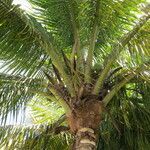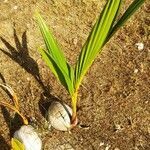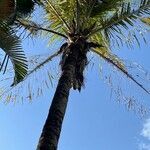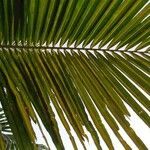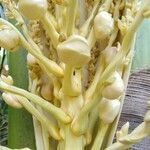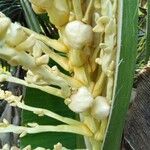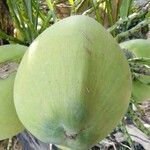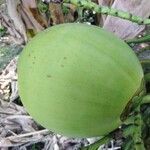Erect but not usually straight, being curved or bent in various ways, some-times 30 m. tall, the bole seeming slender for the size of the crown: leaves bright green, very long, often 5-6 m. and more than 1 m. broad, the many single-rib-bed but striate glabrous pinnae 4-5 cm. broad; peti-ole short and stout: spadices 1-2 m. long, conspicuously forking in axils of the leaves, the prominent yel-low-white pointed caducous staminate flowers about 1 cm. long, pistillate flowers much larger: fruits few to several on a spadix, near the base of the branches, ob-tusely triangular, to 30 cm. or more long-and more than one-half as thick, the nut itself 10-12 cm. thick but variable in size and bearing at its base 3 large eyes representing locules of the ovary.
A palm with an unbranched trunk. The trunk has ring-like leaf scars along it. At the base it is swollen and surrounded by a mass of roots. They grow to about 25 m tall. Dwarf varieties have been produced. The fronds are 2-6 m long. They are divided along the stalk into strap shaped leaflets. The leaflets are 60-90 cm long. They are narrow and tapering. Clusters of large fruit develop beneath the fronds. Male and female flowers are separate on the one stalk. Female flowers are near the base. Flowers are cream. The flowers are covered by boat shaped bracts. About 10-12 fruit/stalk is a good crop. Leaves are up to 5 m long. Fruit can be 25 cm across. The fruit are fibrous. The hard shell inside is filled with coconut milk and the white copra layer.
Palm to 35 m tall; trunk to 30 cm diam. Leaves 10–20, to 7 m long. Pinnae 75–110 each side of rachis, to 130 cm long, to 5 cm wide, regularly arranged, mid green adaxially, light green abaxially. Inflorescence to 2 m long; axes cream-green. Flowers cream. Staminate flower 7–15 mm long, 3–9 mm diam. Pistillate flower 20–40 mm high. Fruit 10–35 cm long, 8–20 cm diam., green, yellow, or orange; mesocarp 10–50 mm thick; endocarp to 8 mm thick.
Stems erect or leaning, smooth. Leaves: segments inserted on rachis in 2 ranks; bract persistent, peduncular, to 1 m, woody. Staminate flowers creamy yellow, 11--13 mm. Fruits green, yellow, or bronzy red when immature, brown when mature; mesocarp dry, fibrous; endocarp brown, bearing 3 germination pores. 2n = 32.
Stems to 20 m tall, 30 cm or more in diam. Pinnae to 100 per side of rachis, regularly arranged and stiffly spreading in same plane. Inflorescences borne among leaves. Fruits greenish to reddish brown, ovoid to irregularly globose, to 30 × 20 cm.
Distinguished by its smooth, rather slender trunk which is seldom straight, its crown of pinnate leaves, and its well-known fruit

